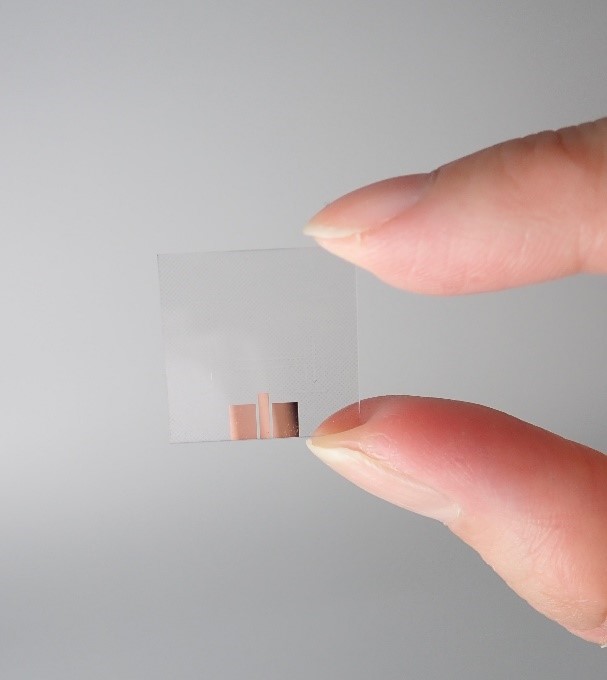November 29, 2018ProductsR&D
AGC Develops a Synthetic Fused Silica Glass Antenna for 5G
Realization of Ultra Low Loss Combined with Brilliant Design
AGC (Headquarters: Tokyo; President: Takuya Shimamura) has succeeded in developing a synthetic fused silica glass antenna for 5G*1 that realizes both transparency and low transmission loss. The company plans to continue research and development aimed at practical use applications that include vehicle-mounted, indoor and outdoor antennas, and begins providing samples in 2019.
5G is expected to start going into service around 2020 to respond to the approaching IoT era, in which all manner of things will be connected via internet. This has generated a demand for materials with low transmission loss to use as substrate in antennas that will be used for frequency bands over 28 GHz. To meet these needs, AGC has been focusing efforts on developing antennas that can operate with extremely low transmission loss, and are ideal for devices and infrastructure using 28 GHz or higher frequency bands.
This latest synthetic fused silica glass antenna developed by AGC has successfully realized ultra-low transmission loss*2 by applying antenna design technology that the company originally developed for the 28 GHz band to AGC's synthetic fused silica glass AQ. The company also succeeded in realizing a transparent antenna pattern by applying its unique micro-fabrication technology. Even when installed in the line-of-sight, these new antennas obstruct visibility as minimally as possible to avoid spoiling the view, which could make them an ideal antenna in applications such as vehicle and indoor/outdoor use, where visibility is paramount.
 Newly developed synthetic fused silica glass antenna
Newly developed synthetic fused silica glass antenna
Under its long-term management strategy, "Vision 2025," the AGC Group has positioned mobility and electronics business as key strategic business areas. In particular, AGC regards the practical application of 5G to be a major business opportunity, and accordingly has focused efforts on developing glass antennas that add wireless base station capabilities to existing windows or can be used as glass-mounted antennas for connected cars; increasing the production of fluoropolymers for printed circuit boards; and acquiring a US-based business in the printed circuit board rigid CCL (Copper Clad Laminate) sector. AGC is committed to aggressively expanding its business while also contributing to the development of next-generation high-speed communication technologies by combining the technologies in glass, electronics, chemicals, and ceramics that the company has built up and refined through years of experience.
― NOTES ―
*1 Refers to a 5th-generation mobile communication system. Required properties are "high-speed with large-capacity," "ultra-high-speed reliability with low-latency," and an "ultra- high-capacity connection."
*2 Means level of deterioration of an electrical signal running through the communication line is extremely low.
*2 Means level of deterioration of an electrical signal running through the communication line is extremely low.
― REFERENCE ―
■ Download images
Above images can be downloaded by visiting the URL or reading the QR code listed below.
https://agc2.ent.box.com/v/galssantenna
* There are no restrictions on image use.
* Please be sure to credit the source as follows when using: "Images provided by AGC"
https://agc2.ent.box.com/v/galssantenna
* There are no restrictions on image use.
* Please be sure to credit the source as follows when using: "Images provided by AGC"
- MEDIA INQUIRIES
- Kazumi Tamaki, General Manager, Corporate Communications & Investor Relations Division
AGC Inc. - Contact: Ai Ota
- TEL: +81-3-3218-5603
- E-mail: info-pr@agc.com

